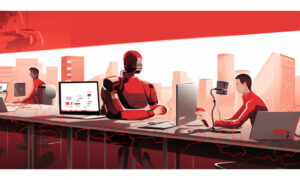Predicting workforce gaps with data-powered HR: Danny Hodgson, Co-Founder, Foresight
- 4 Min Read
Workforce planning has never been a more precarious exercise. High attrition creates holes in teams, and a fast-transforming workplace has put a skills war in sway that will rock many organisations to the core. How can HR technology save the day?
- Author: Michael Hocking
- Date published: Sep 25, 2019
- Categories

What is the true potential of HR and how can technology help us to achieve it?
Workforce planning has never been a more precarious exercise. According to The Deloitte Millennial Survey 2018, 43% of those surveyed “envision leaving their jobs within two years, and only 28% are looking to stay beyond five years… up seven percentage points from the year prior.” In addition to high attrition, a fast-transforming workplace has put a skills war in sway that will rock many organisations to the core.
In this installment of our HRD Tech Founders Q&A series, Danny Hodgson, Co-Founder, Foresight, discusses the power of HR tech in providing business insights to HR leaders, empowering them to effectively plan for workforce gaps in the near future.
What is Foresight?
Foresight is the easiest way for a business to understand what future workforce “gaps” it will be facing in the future 12-24 months. Using only actual information retrieved from operational managers, Foresight delivers substantial insights to HR teams about what, when and why vacancies will be arising. Using this insight, and a powerful automated notification engine, customers proactively plan how they will “buy” or “build” the skills they need to ensure that these gaps are filled at the optimal time for organizational productivity; meaning far less unproductive “Empty Chair Time,” valuable handover periods, better bottom line performance and a happier C-Suite!
Why was it necessary to create Foresight?
HR delivery is reactive. It has been since the earliest days of the Ulrich model and centralization of HR. For the gains in consistency and economy of scale that centralization of HR brought, there have been significant losses in HR-to-business understanding and connectivity – ultimately leading to a huge loss of productivity and a reduction in the perceived value of HR as a key business enabler. It is no longer an option to have HR professionals embedded across a business, so Foresight provides the technological solution to bridge the gap.
Why is HR technology crucial to the success of a business?
Having the right people, in the right roles is a top priority of any leadership team, as it is fundamental to business plan delivery and achieving competitive advantage. However it is not enough any more to just have the right people in the right roles, an organization needs to ensure that this is achieved all of the time (or as close to as possible). As, when there isn’t someone doing a job needed by a company there is a direct link to reduced productivity, reduced team output and ultimately reduced bottom line performance.
How can an organization most effectively implement new HR technology?
Thoughtfully! Giving consideration to the balance between achieving a “central point of truth” for data, and not compromising on capability for the sake of opting for one mega system that says it “does it all.” Implementation is best done iteratively, or in phases. Don’t go live across your entire organsation at the same time. Design and plan what you want, segment your business into appropriate chunks, build and launch to the first area. Then review, take stock, learn, improve, rebuild and launch to the next area. If this launch goes perfectly, roll out wider. If not repeat the review process. It may take a little longer to get everyone live but there will be far less time and money spent redesigning an entire workflow. You’ll also find you have higher stakeholder engagement too!
What do you think is the biggest challenge affecting organisations today?
Competency and capability to take on the changing world of work. There are now 5 or more age demographics in the workplace, yet for the most part, the “leaders” of every large business are from the same 1 or 2 demographics. Having “grown up” with ideals such as remote working was a priviledge not a right and so on, the challenge is in really embracing a work culture that is concerned only with making things better – better employee engagement, better business performance, better market share; whist harnessing the ever improving power that technology can bring to the mix.
Which emerging technologies do you think will transform HR in the future?
Anything that can eliminate low value, repetitive, highly administrative tasks; and anything that can better connect HR with the “coal face” of the business they operate within. Doing these two things in tandem will rapidly propel HR to business enabler / profit enabler, rather than the “people police”, or worse “admin centre” that HR is perceived to be in too many an organization.








